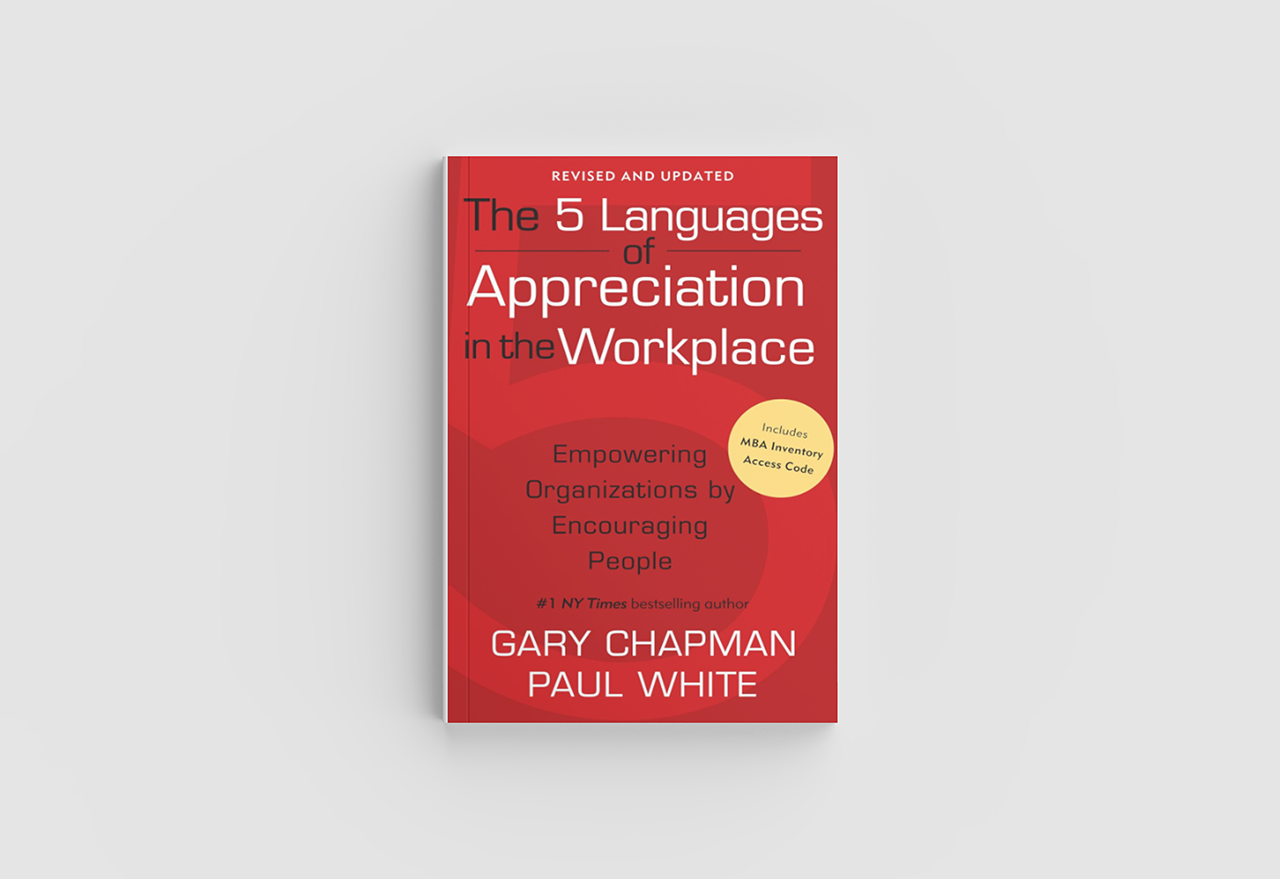Never Split the Difference – Negotiating As If Your Life Depended On It
This Month's SelectionNever Split the Difference – Negotiating As If Your Life Depended On It, by Chris Voss (Author), Tahl Raz (Author)The ...
6 min read
![]() Nicole R. Smith
Feb 21, 2024 9:00:00 AM
Nicole R. Smith
Feb 21, 2024 9:00:00 AM

This Month's Selection
The 5 Languages of Appreciation in the Workplace: Empowering Organizations by Encouraging People, by Gary Chapman and Paul White
The thirteenth in a series of Better Impact Book Bites
A taste of great books worth consuming.
It’s that time of the year when love abounds so I thought it would be timely; probably not as perfect as during National Volunteer Week or National Employee Appreciation Day, but probably a bit better because it gives you time to read up on it and prepare!
This book is 205 pages, available as an audiobook, and very easy to read. It will give you the tools to improve morale, create a more positive environment for employees and volunteers, and increase retention. It also provides tools for you to learn about your language of appreciation as well as those of your colleagues and volunteers. Dr. Paul White, one of the authors, is a speaker, psychologist, and leadership trainer who "makes work relationships work." For the past 25 years, he's improved numerous businesses, non-profit organizations, schools and medical facilities by helping them create positive workplace relationships/environments and increase engagement and productivity. Clients include Microsoft, NASA, and L’Oreal to name a few along with a number of hospitals, schools, government agencies and over 750 colleges and universities. Gary Chapman, the co-author, is a speaker, counselor, and has a passion for people and helping them form lasting relationships. He is the best-selling author of The 5 Love Languages® series and the director of Marriage and Family Life Consultants, Inc. Gary travels the world presenting seminars, and his radio programs air on more than 400 stations.
This book focuses on employees in the workplace so a lot of what you will read will be regarding people with an “employee” title. However, just as employees are people, volunteers are people too. So, with that, I will often switch out the word volunteer and/or employee with “people” because the principles the authors speak of are all regarding people and apply across the board, regardless of which hat they happen to be wearing.
People want to feel appreciated, period. From CEOs to housekeeping staff, 64% of Americans who leave jobs say they do so because they don’t feel appreciated. Most people know this anecdotally. Where it gets challenging is not realizing that what makes one person feel appreciated can make another feel just the opposite; rendering efforts ineffective.
This chapter covers why “just say thank you” isn’t always the best advice, how understanding people’s language of appreciation can shift the entire culture of a business or organization, what happens when appreciation misses the mark and how appreciation is directly tied to engagement.
This chapter covers why people leave jobs, organizations, and/or volunteer programs and what the data reveals about job satisfaction. It discusses the tremendous cost of turnover and how satisfaction with the contribution one is making is directly tied to long-term commitments, thereby increasing retention rates.
Appreciation Language #1. This chapter discusses how it reveals itself in praise for accomplishments, affirmation for character and words that focus on positive personality traits. It also cautions on hollow praise, how it can actually backfire if the recipient doesn’t feel as though it is genuine and the most egregious mistake of all, neglect; simply not actually verbalizing and telling someone they are appreciated. It gives tools and suggestions on the how, when, and for whom Words of Affirmation work best.
Appreciation Language #2: This chapter describes what exactly is meant by “quality time” and how to maximize it to make it meaningful. In other words, how to give someone your undivided attention. It is a bit more difficult than one may think, especially given all our technological distractions these days. The reminder that for someone whose language of appreciation is quality time, the result it has on that team member can be extremely impactful.
Appreciation Language #3: This chapter explains what acts of service are and how to be intentional and effective with them. It discusses how not being intentional with help to a fellow colleague or volunteer can backfire and actually have the opposite effect. It gives great tips on how to help effectively versus doing it just for show, or begrudgingly.
Appreciation Language #4: This chapter discusses how powerful giving the right gift can be. For this to land well with the recipient, it is important that who the person is and the gift they are receiving match. It is important to understand that giving a gift to someone whose appreciation language may be acts of service will not have the same effect. It is also important to note that you must give a gift that the person values. The chapter is full of tips on how to do just that.
Appreciation Language #5. This chapter reveals how this one is a bit tricky, especially in the workplace. It talks about the cautions of this particular language but also, the benefits when done in the appropriate context, like a well-timed high-five or fist pump.
This chapter discusses how your own personal, least valued language of appreciation can be your blind spot when showing appreciation to others. The authors discuss how understanding your team’s appreciation languages is critical to your success as their leader. You may begin to think that they are ungrateful and don’t appreciate all that you do for them. This hit a nerve for me and made me realize perhaps I was missing the mark on their languages of appreciation!
As the title suggests, this chapter discusses the fundamental differences between the two and why one isn’t as recommended due to the limitations that come along with it. Can you guess which one it is? Well, I am not telling you, you will have to read it. It is fascinating. I had never considered these viewpoints before.
This chapter is broken down by industry and what appreciation can look like. The industries they chose to use as examples are manufacturing firms, schools, nonprofit organizations, family-owned businesses, financial services, medical/dental offices, ministries/churches, government, and law, to name a few. It was interesting to see what it can look like across industries.
This chapter discusses the challenges when it comes to volunteers. It talks about the importance of “job” satisfaction for volunteers, why people start volunteering and why they continue. Lastly, it talks about how appreciation, when it comes to volunteers, can make a difference.
This chapter discusses how although a person’s primary language tends to remain the same throughout their lifespan, circumstances such as life stages and/or interpersonal dynamics may cause the secondary language to temporarily move up as the primary language of appreciation.
This chapter helps you to identify and overcome the challenges we face when it comes to showing appreciation to the people we work with, lead, and/or serve. The authors tackle the challenge of busyness, the belief that communicating appreciation isn’t important to your organization, feeling overwhelmed with existing responsibilities, structural and logistical issues, personal discomfort with communication appreciation (perhaps because you yourself don’t believe you are or need to be shown appreciation) and lastly, the “weirdness” factor.
If you truly don’t appreciate the people you interact with, this chapter helps you to dig into why that may be. Is it performance based, lack of training, or maybe even an outward reflection of how we see ourselves? Scary to think about it. This chapter helps to identify reasons and offers suggestions on what to do.
This chapter discusses what the MBA model is (Motivation by Appreciation) as well as explaining how you can use all its tools to help you discover the appreciation language of those you lead and those you work with.
This last section isn’t really set up as a chapter, but a call to action. It gives you actionable tips and tricks on how to take what you have learned and apply it to your situation in real-time.
As a leader of volunteers, appreciation of people is fundamental to my job. This book, however, helped me to understand appreciation and recognition more in depth with volunteers, but more so laterally with my colleagues. Leaders of volunteers often complain that their colleagues don’t appreciate them, but do WE appreciate our colleagues and what THEY bring to the table? Additionally, I must admit, the chapter on volunteers rubbed me the wrong way a bit, but that is because volunteerism is what I live, eat, and breathe; whereas to the authors, it was literally just a chapter in a book. At the end of the day, I am glad they thought enough to add the chapter into the book and the majority of what they were saying was accurate, so that is what I am going to land with. With National Volunteer Appreciation Week (USA) coming up in a few months, it definitely gives us something to think about this time around as we aim to show appreciation to those hidden in plain sight.
Other Related Links
Featured Posts

This Month's SelectionNever Split the Difference – Negotiating As If Your Life Depended On It, by Chris Voss (Author), Tahl Raz (Author)The ...

This Month's SelectionWho Moved My Cheese, by Spencer Johnson, M.D.The seventeenth in a series of Better Impact Book BitesA taste of great books...

This Month’s Selection: How To Win Friends & Influence People By Dale Carnegie The sixth in a series of Better Impact Book BitesA taste of great...